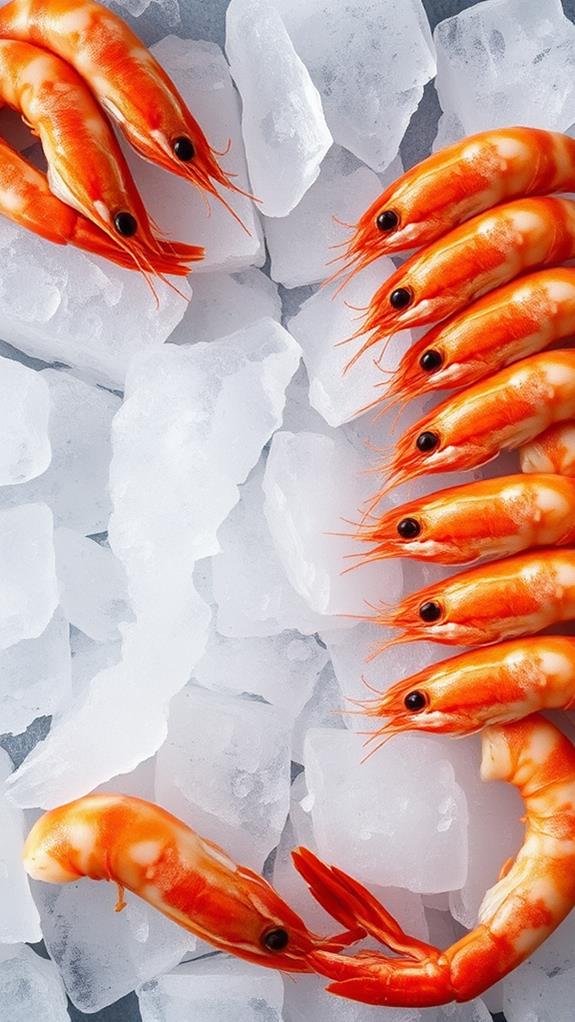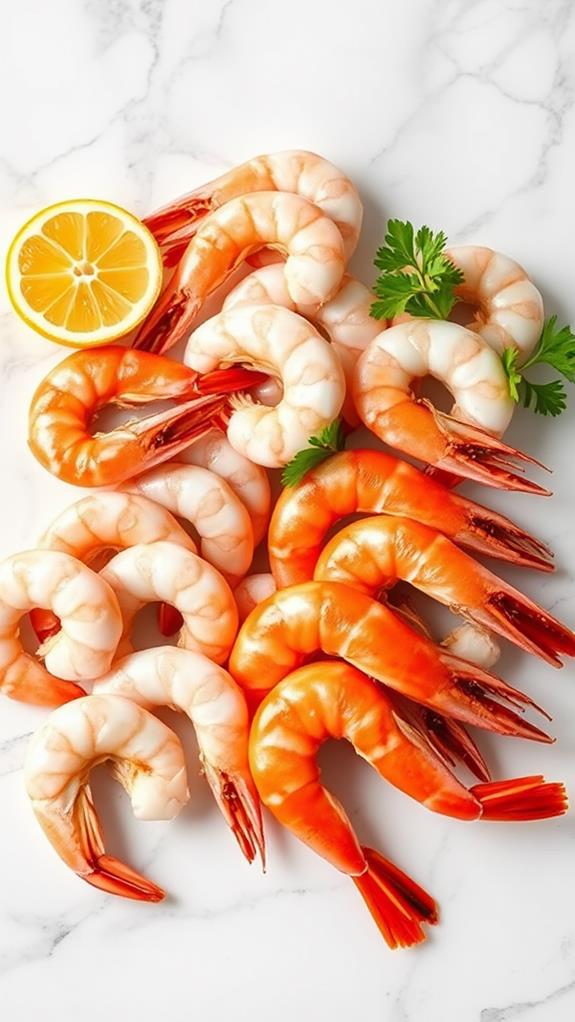Is Argentinian Shrimp Safe to Eat
Argentinian shrimp are generally safe to eat when properly sourced and prepared. These wild-caught crustaceans from the pristine waters off Argentina's Atlantic coast offer a sweet, lobster-like flavor and firm texture. They're typically harvested using sustainable fishing methods, adhering to quotas and seasonal restrictions. While they may contain trace contaminants like heavy metals and microplastics, proper handling and cooking can minimize risks. As with any seafood, there's a potential for foodborne illnesses, so it's essential to purchase from reputable sources and follow safe cooking practices. If you're concerned about environmental impact, look for certifications like the Marine Stewardship Council (MSC). Exploring further will reveal more about their unique characteristics and how they compare to other shrimp varieties.
This post may contain affiliate links. If you make a purchase through these links, I may earn a commission at no additional cost to you. Additionally, portions of this post may be generated using artificial intelligence (AI) technology. While we strive for accuracy, please be aware that AI-generated content may not always be perfect and should be fact-checked when necessary.
The Spatula Scoops
- Argentinian shrimp are generally safe to eat when properly handled and cooked.
- Wild-caught methods reduce the risk of bacterial contamination compared to farmed varieties.
- Potential health concerns include heavy metals, microplastics, and foodborne illnesses like Salmonella and Vibrio.
- Sustainable fishing practices and government regulations help ensure safety and quality.
- Individuals with shellfish allergies should avoid Argentinian shrimp due to potential allergic reactions.
Origins of Argentinian Shrimp

In the cold, pristine waters off Argentina's Atlantic coast, you'll find the home of Argentinian shrimp. These crustaceans thrive in the nutrient-rich environment of the Patagonian Shelf, a vast continental platform extending from Argentina's coastline. The region's unique ecosystem, characterized by cold currents and upwelling phenomena, contributes to the shrimp's distinctive flavor and texture. Like other shrimp varieties, Argentinian shrimp are generally safeguarded to consume when properly handled and cooked, despite potential concerns about freezer burn affecting quality.
Argentinian shrimp, scientifically known as Pleoticus muelleri, are wild-caught using sustainable fishing methods. They're harvested primarily in the provinces of Chubut and Santa Cruz, where strict regulations guarantee the preservation of the species and its habitat. You'll find that these shrimp are larger and sweeter than many other varieties, often compared to lobster in taste and texture.
The fishing industry for Argentinian shrimp began to flourish in the 1980s, quickly becoming a significant export for the country. Today, you'll see these shrimp in markets worldwide, valued for their quality and versatility in culinary applications. Their popularity has led to increased demand, prompting careful management of the fishery to maintain sustainability and prevent overfishing.
Farming and Harvesting Practices
Three key factors distinguish Argentinian shrimp harvesting: wild-caught methods, sustainable practices, and strict regulation. You'll find that most Argentinian shrimp are caught in the wild rather than farmed, which contributes to their superior flavor and texture. The fishing industry employs trawling techniques, using nets to catch shrimp in their natural habitat. This method is similar to how sushi-grade tuna is sourced, guaranteeing high-quality products for consumers. Additionally, wild-caught shrimp often have a lower risk of bacterial contamination compared to farmed varieties.
Sustainability is a top priority in Argentina's shrimp industry. Fisheries adhere to quotas and seasonal restrictions to prevent overfishing and maintain healthy shrimp populations. These measures guarantee the long-term viability of the industry while preserving marine ecosystems.
The Argentinian government enforces strict regulations on shrimp harvesting. You can be confident that the shrimp you're buying meets high standards for quality and safety. Fisheries must comply with rigorous inspections and follow guidelines for handling and processing.
These practices contribute to the overall quality and safety of Argentinian shrimp. By focusing on wild-caught methods, sustainability, and regulatory compliance, the industry maintains its reputation for producing premium seafood. When you choose Argentinian shrimp, you're selecting a product that's been harvested responsibly and with care for both consumers and the environment.
Potential Health Concerns

While Argentinian shrimp is generally regarded safe to consume, there are a few potential health concerns you should be mindful of. One primary concern is the presence of contaminants, such as heavy metals and microplastics, which can accumulate in marine life. These pollutants may pose health risks if consumed in large quantities over time. It's crucial to recognize that proper storage and preservation practices can help maintain the quality and safety of frozen shrimp, including Argentinian varieties. Maintaining a consistent freezer temperature and using appropriate packaging can prevent freezer burn and extend shelf life.
Another issue to ponder is the potential for foodborne illnesses. Like all seafood, Argentinian shrimp can harbor harmful bacteria if not properly handled or cooked. Salmonella and Vibrio are two common pathogens that can cause gastrointestinal distress.
You should also be cognizant of allergies. Shellfish, including shrimp, are among the top eight allergens. If you're allergic to other types of shellfish, it's best to avoid Argentinian shrimp as well.
Lastly, reflect on the environmental impact of your consumption. While not directly related to your health, overfishing can lead to ecosystem imbalances that may indirectly affect human well-being. By choosing sustainably sourced Argentinian shrimp, you're supporting practices that help maintain the long-term health of marine environments and, by extension, our food supply.
Sustainability and Environmental Impact
Beyond health considerations, the sustainability of Argentinian shrimp fishing practices plays a key role in their overall safety for consumption. When you're choosing seafood, it's essential to evaluate the environmental impact of fishing methods. Argentina's shrimp industry has made efforts to implement sustainable practices, but challenges remain. Chile, a neighboring country, faces similar challenges with its extensive coastline and rich marine biodiversity, emphasizing the regional importance of sustainable fishing practices.
The country uses a management system that includes seasonal closures and gear restrictions to protect shrimp populations. However, bycatch—the unintentional capture of non-target species—remains a concern. Trawling, the primary method used to catch Argentinian shrimp, can damage seafloor habitats and affect other marine life.
To make informed choices, you can look for certifications like the Marine Stewardship Council (MSC) label, which indicates sustainable fishing practices. Some Argentinian shrimp fisheries have achieved MSC certification, demonstrating their commitment to environmental stewardship.
When purchasing Argentinian shrimp, you're not just considering your health but also the health of marine ecosystems. By supporting sustainable fisheries, you're contributing to the long-term viability of shrimp populations and the broader marine environment. Always check for sustainability certifications and research the latest information on fishing practices to make eco-conscious decisions.
Comparison With Other Shrimp Varieties

Argentinian shrimp stand out among other varieties in several key ways. When you compare them to popular options like tiger shrimp or white shrimp, you'll notice distinct differences in taste, texture, and appearance. Argentinian shrimp are known for their sweet, lobster-like flavor and firm texture, setting them apart from milder-tasting varieties.
Let's break down the comparison:
| Characteristic | Argentinian Shrimp | Tiger Shrimp | White Shrimp |
|---|---|---|---|
| Flavor | Sweet, lobster-like | Mild, briny | Mild, sweet |
| Texture | Firm | Tender | Soft |
| Size | Large | Very large | Medium |
| Color (raw) | Pink | Gray with black stripes | Gray or white |
You'll find that Argentinian shrimp are often larger than white shrimp but may be slightly smaller than tiger shrimp. Their natural pink color when raw is unique, as most other shrimp varieties are grayish before cooking. This distinctive hue is due to their diet and habitat in the cold waters off Argentina's coast. When it comes to nutrition, Argentinian shrimp are comparable to other varieties, offering a good source of protein and omega-3 fatty acids.
Frequently Asked Questions
How Should I Prepare and Cook Argentinian Shrimp?
To prepare Argentinian shrimp, you'll want to start by thawing them if frozen. Rinse the shrimp and pat them dry. You can cook them with or without the shell, depending on your preference. For a simple preparation, sauté them in olive oil with garlic and lemon juice. They cook quickly, usually in 2-3 minutes per side, until pink and opaque. You can also grill, boil, or bake them. Serve with your favorite seasonings or sauces for a delicious meal.
Can Pregnant Women Safely Consume Argentinian Shrimp?
Did you know that 85% of pregnant women consume seafood during their pregnancy? If you're expecting, you might wonder about Argentinian shrimp. Generally, it's safe to eat when properly cooked. Guarantee it's thoroughly cooked to 145°F (62.8°C) to eliminate harmful bacteria. Limit your intake to 8-12 ounces of low-mercury seafood per week. Argentinian shrimp is typically low in mercury, making it a good choice. However, always consult your healthcare provider for personalized advice on your diet during pregnancy.
What Is the Shelf Life of Frozen Argentinian Shrimp?
You'll find that frozen Argentinian shrimp typically has a shelf life of 3 to 6 months when stored properly in your freezer. To maximize freshness, guarantee your freezer maintains a consistent temperature of 0°F (-18°C) or below. It's vital to keep the shrimp in its original packaging or transfer it to an airtight, freezer-safe container. Remember, while frozen shrimp can last longer, it's best to consume it within this timeframe for ideal flavor and texture.
Are There Any Specific Wine Pairings Recommended for Argentinian Shrimp Dishes?
You'll find that Argentinian shrimp pairs wonderfully with various wines. For lighter preparations, try a crisp Sauvignon Blanc or Pinot Grigio. These white wines complement the shrimp's delicate flavor without overpowering it. If you're serving a richer dish, like garlic butter shrimp, opt for a lightly oaked Chardonnay. For grilled or spicy shrimp dishes, consider a dry rosé or even a light-bodied red like Pinot Noir. Remember, personal preference plays a role, so don't be afraid to experiment.
How Can I Tell if Argentinian Shrimp Has Gone Bad?
To tell if Argentinian shrimp has gone bad, you'll want to use your senses. Check for a strong, unpleasant odor—fresh shrimp should have a mild, ocean-like scent. Look for discoloration or slimy texture, which indicate spoilage. Feel the shrimp; it should be firm, not mushy. If you notice black spots or edges, that's a sign of decay. Trust your instincts—if something seems off, it's best to discard the shrimp to avoid potential food poisoning.
Conclusion
You've learned that Argentinian shrimp is generally safe to eat, but it's important to be aware of potential concerns. While farming practices are mostly sustainable, there's always room for improvement. Remember, like with any seafood, proper handling and cooking are vital. For instance, if you're preparing Argentinian red shrimp, make sure they're cooked to an internal temperature of 145°F to eliminate any harmful bacteria. Ultimately, when consumed as part of a balanced diet, Argentinian shrimp can be a nutritious and delicious option.





